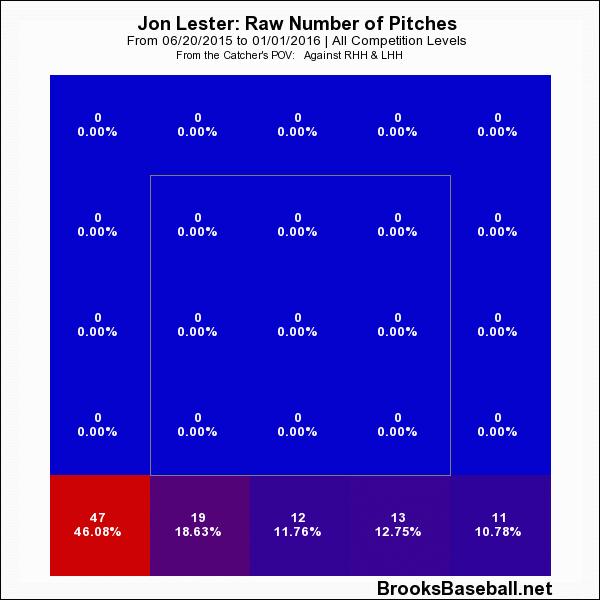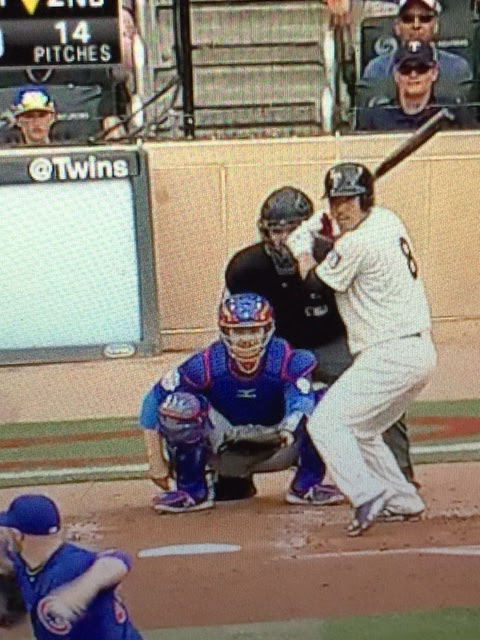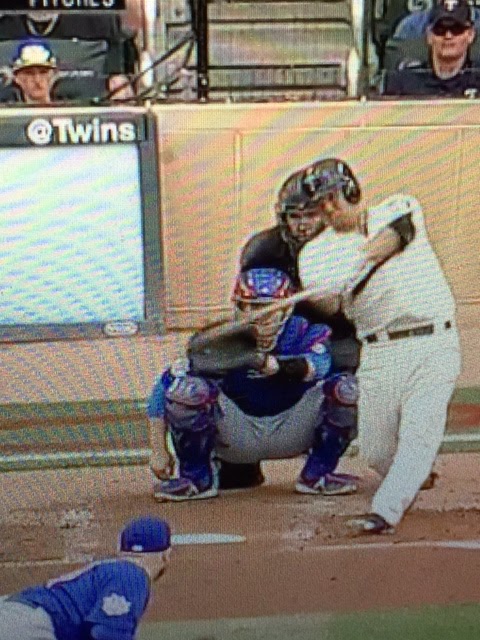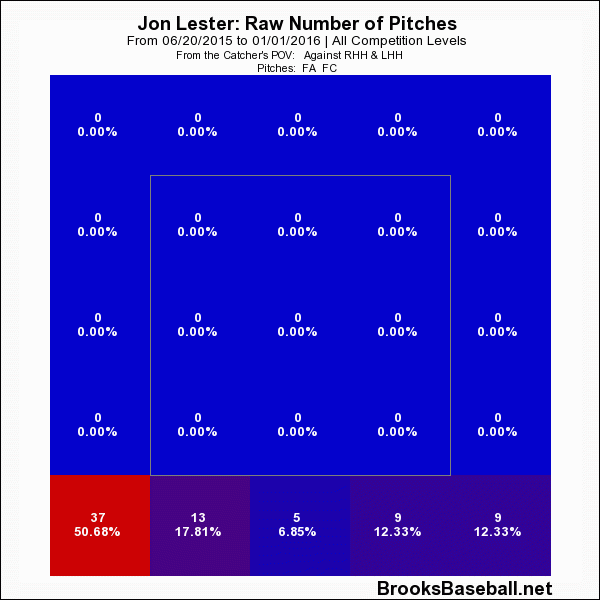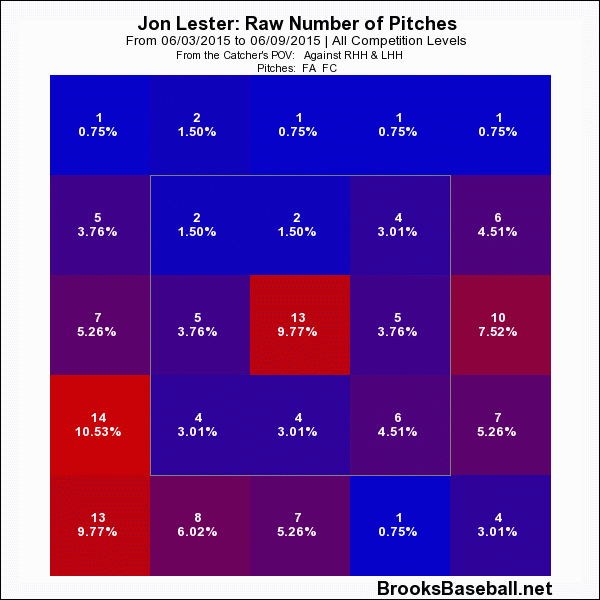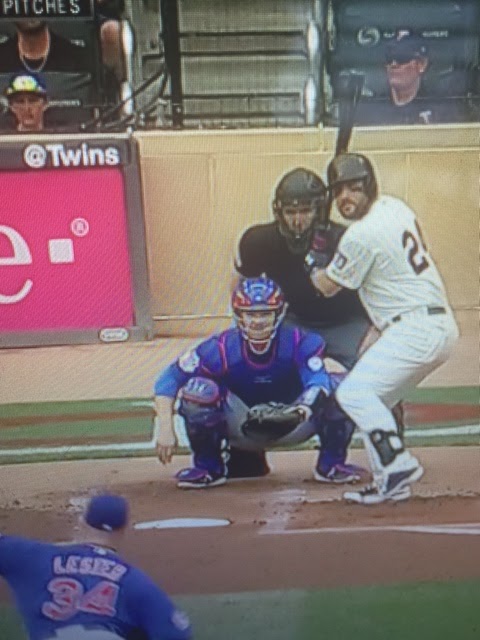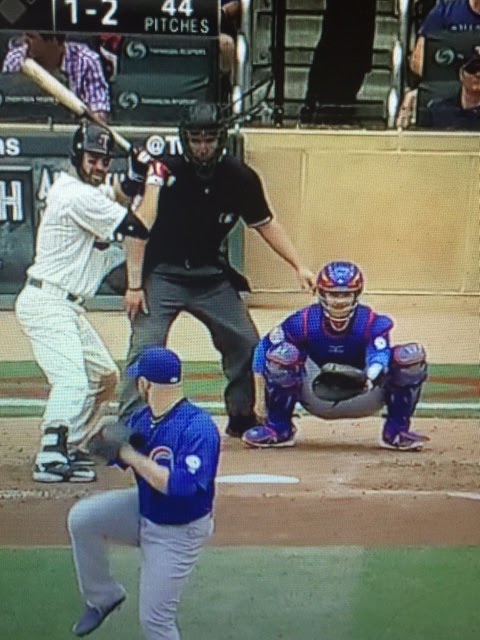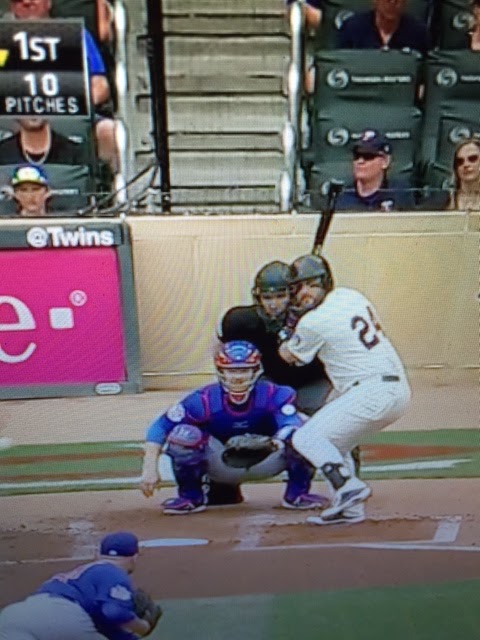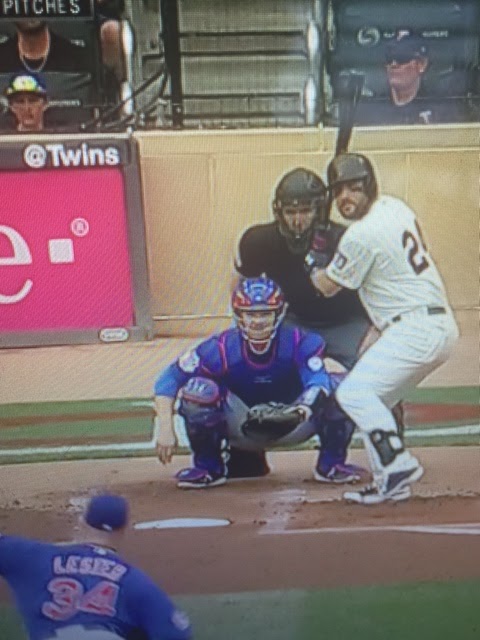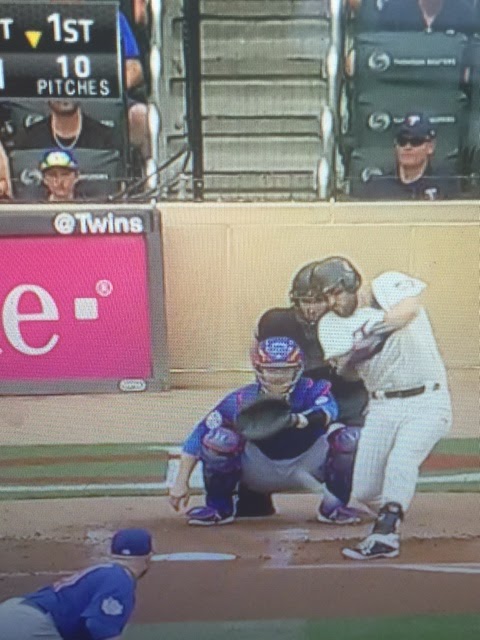Date: June 20
Opponent: Minnesota Twins
Location: Target Field
Introduction
Last summer’s Fargo miniseries, set in the grim, icy Minnesota tundra, featured Lorne Malvo, a calculating, chameleon-like, few-steps-beyond psychotic killer-for-hire played by Billy Bob Thornton. In one attempt to track down a target, Thornton’s Malvo took on the persona of a personable Midwestern dentist whose response to good news or pleasant situations was a point of the fingers and an enthusiastic, “Aces.”
Jon Lester has never adopted an alias as a Midwestern dentist, as far as we know, but after a rough two-start stretch to open June, his performances against Cincinnati and in the late Minnesota springtime have him looking “Aces.”
Like we mentioned, it has been a tale of two Junes for Lester:
| IP | First Pitch Strike % | ERA | WHIP | H | K% | BB% | |
| Starts 11-12 | 9.1 | 57.5% | 10.61 | 2.25 | 18 | 19.2% | 6.4% |
| Starts 13-14 | 13.1 | 75% | 1.35 | 0.825 | 8 | 22.9% | 6.3% |
True, the Twins did not present the fiercest challenge. There has been much discussion about the Twins riding a wave of intangibles and overproduction to their 37-30 start, with the numbers suggesting their offense would not produce over 162 games. However, no matter how anemic the offense, since opening in 2010, Target Field has not been kind to Lester. In four starts, he’s 0-2 with 4.91 ERA and 1.60 WHIP.
The Twins entered Saturday ranking in the bottom five of the AL in most offensive categories, including runs scored, home runs, OPS, and ISO. They have just three everyday players with a .700 OPS or higher (Brian Dozier, Trevor Plouffe, and Torii Hunter), with those same three being the only players with a .260 TAv or higher. While the team overall has been at the bottom of the AL, they have been better against left-handed pitchers, hitting .261/.317/.388. The Twins came in struggling offensively, having scored four runs or less in 11 of their past 13 games.
Against the Twins, Lester returned to getting ahead of batters (70 percent). As we referenced in the Introduction, in his past two starts, Lester has thrown first pitch strikes to a combined 75 percent of batters (36 of 48). He tied his season low for hits allowed (3), and allowed six baserunners or fewer for the fourth time in 14 starts. It was also only his third start of the season in which he allowed one or fewer extra-base hits. Lester also topped 100 pitches for the first time in June. He once again looked like Jon Lester.
Most importantly, Lester consistently located his fastballs on both sides of the plate (see Trends section). And as you can see below, Lester kept the ball down and on the corners, with some help from Ross’ positioning (again, see Trends section):
Yes, there was a 30-pitch inning (35 pitches in the fifth), Lester’s fourth in five starts. The effect, however, was mitigated slightly by Lester needing just 47 pitches to get through innings one, two, four, and six. There was also yet another home run on a fastball that missed its spot (see Pitch Breakdown section).
Overall, though, Lester was sharp and efficient against the Twins. His cutter looked as good as it has at any point this season, and he consistently got ahead of Twins batters. Despite the three walks, it was one of Lester’s best starts of 2015. Keep scrolling to see how it all went down. Aces.
Traditional Line
6.1 IP, 3 H, 7 K, 3 BB, 1 ER
Pitch Breakdown
102 pitches (68 strikes)
| Total | Velocity (Max) | AVG | SLG | BABIP | |
| Four-Seam | 46 | 92.8 (95.2) | .250 | .625 | .200 |
| Cutter | 27 | 89.4 (91.8) | .000 | .000 | .000 |
| Sinker | 7 | 91.6 (92.8) | .333 | .333 | .500 |
| Change-Up | 2 | 85.5 (86.0) | .000 | .000 | .000 |
| Curveball | 20 | 76.3 (80.0) | .000 | .000 | .000 |
As we mentioned above, Lester’s cutter was sharp, as the Twins went 0-for-7 with three strikeouts. He kept the ball down and off the plate, and induced four whiffs on the cutter.
Lester got ahead of 16 of 23 batters, with 12 of the 16 first-pitch strikes coming on the four-seamer or cutter.
The four-seamer was solid, despite him issuing two walks and the home run to Kurt Suzuki. On the first pitch to Kurt Suzuki, Ross set-up low and inside, but not quite as far off the plate as he did most of the day (again, see Trends section) :
Lester, however, missed the spot with a 93.8 mph four-seamer up and out over the plate:
As has often been the case this season, it was an instance of failed execution as opposed to poor pitch selection. Suzuki entered the game 3-for-16 (all singles) against four-seamers from left-handed pitchers.
Despite Suzuki’s home run, Lester used his four-seamer and cutter to pound the inside corner to right-handed batters and stayed away from left-handed batters:
Compare that to his starts against Detroit and Miami, when many of his four-seamers and cutters were left up in the zone and/or out over the plate:
Lester went to his curveball with the greatest frequency (19.6 percent) in his four June starts. As has been the case all season, when Lester is able to get ahead with four-seam and cut fastballs, his curveball frequency increases. Of his five best Game Scores in 2015, four have come in the starts in which he has thrown his curve at least 19.0 percent of pitches.
Trends
In 2015, Lester’s greatest struggle has been consistently locating his fastballs. We covered his stretch of allowing seven home runs in six starts off of missed fastballs, as well as the damage done by the Tigers on fastballs up and out over the plate. So, how do you attack a problem that has lingered for nearly half the season?
During last Sunday night’s start against Cincinnati, it was clear from the outset that Lester and David Ross were attempting to attack his biggest problem in 2015 by setting up further off the plate, or “right under the batter’s armpit” as Curt Schilling noted during the first inning. The positioning of Ross had an explicit message: “If you’re going to miss, miss in here,” said John Kruk, noted member of the Alpha Betas from Adams College.
The approach was effective, as Lester threw his highest percentage of first-pitch strikes (80 percent) of 2015, issued no walks, and had his second-best start of the season by baserunners allowed (5) and Game Score (67).
It was so effective, in fact, that Lester and Ross continued it against the Twins. From the first inning, Ross setting up with his foot planted firmly in the batter’s box, with his glove more than six inches off the plate. We could provide dozens of examples from Saturday’s game, but here are just a few below:
In the first inning, a 90-mph cutter to Plouffe (see Key-At Bat section):
In the second inning, a 93-mph four-seamer for a called first strike:
In the same at-bat, Lester and Ross moved off the other corner of the plate with a 93-mph four-seamer for a called strike three:
In the fourth inning, a 92.8-mph sinker to Mauer for a called strike three:
In the fifth inning, a 91-mph cutter to Dozier for a weak line drive to Starlin Castro caught for the third out:
For two starts, Lester and Ross have been able to steal strikes and minimize missed spots by rarely even attempting to go near the middle of the plate. It has been an extremely beneficial trend, but is it sustainable?
Key At-Bat/Sequence
Inning: First Inning
Score: 0-0
Situation: One out, Eddie Rosario on second base, Joe Mauer on first base
Batter(s): Trevor Plouffe
For a brief moment on Saturday, it looked like the wheels might be coming off early for Lester. With one out, Eddie Rosario roped a single back up the middle on a 90-mph sinker that missed out over the plate. Lester only came anywhere near the strike zone on one of six pitches to Joe Mauer, and walked him on 3-2 four-seam fastball way off the plate.
With one out and two on, up to the plate stepped Trevor Plouffe, one of the aforementioned three above league average Twins hitters in 2015, who had been hitting left-handed pitchers at .263/.352/.447.
On the first pitch, Ross set up inside, with his left foot planted almost halfway into the batter’s box:
Lester hit his spot with a 94.6-mph four-seamer, which is probably why he was able to steal a called first strike.
On the 0-1 pitch, Ross set-up in the exact same spot:
Lester missed slightly up from his spot with the 91.0-mph cutter:
However, due to where Ross set-up, it was far enough in on the hands of Plouffe that he could not get the barrel of the bat on the ball. He chopped the cutter to Castro, who started a 4-6-3 double play that ended the first inning.
The pitch selection was solid, as Plouffe entered the game hitting 1-for-4 with two strikeouts against cut-fastballs from left-handers this season. Lester executed the pitch adequately, and the Twins would only have two more batters reach second base.
Keep-In-Mind
By ERA+, Lester is an above-league average pitcher for the first time in 2015 (101 ERA+).
He has not won a decision since May 16, but that is due partly to his 3.14 runs per game in support (eighth lowest in the NL). Early June was rough, but he is again looking like the frontline starter for a team who entered Tuesday with the fourth-best playoff odds in the NL at 74.2 percent.
Conclusion
The Twins are hardly an offensive power, but Lester has appeared to regain his form from May. He is again getting ahead of batters with his fastballs, and effectively utilizing his curveball. It will be interesting to see if Lester and Ross can continue to find success so far off the plate. It is doubtful that it is a long-term solution, but it has put Lester back on track. Aces.
Season to Date
4-5, 3.80 ERA, 1.336 WHIP, 22.4 K%, 6.3 BB%
Next Start
Thursday, June 25th vs Los Angeles Dodgers (Carlos Frias)
Lead photo courtesy of Jesse Johnson-USA TODAY Sports

